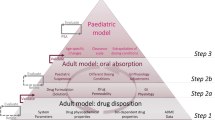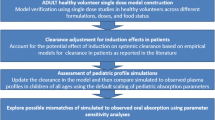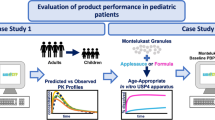Abstract
Paediatric pharmaceutics has become an important topic, but currently, there is an incomplete knowledge of paediatric gastrointestinal physiology and adequate biopharmaceutical tools still have to be developed. The present study aimed to increase the understanding of oral drug absorption in paediatric populations by using physiologically based pharmacokinetic (PBPK) modelling and in vitro dissolution testing. The oral absorption of two model compounds, sotalol and paracetamol, was studied by collection of reported pharmacokinetic profiles from adult and paediatric subjects. A PBPK model based on input parameters collected from the literature was first developed and validated in adults before being extrapolated to paediatric age groups. The accuracy of the model simulations was assessed by comparison to the observed pharmacokinetic profiles, and in the case of discrepancy, further investigations were made via parameter sensitivity analysis and in vitro dissolution testing. The PBPK models accurately predicted sotalol and paracetamol exposure in adult populations. An accurate simulation was also obtained after model extrapolation to children older than 2 years of age. However, the simulation in infants and newborns resulted in a discrepancy, which was further analysed. Dissolution testing suggested no significant difference in the drug release rate between paediatric and adult age groups. In contrast, mean gastric emptying time seemed to be underestimated in infants and newborns, and optimisation of this input parameter improved the prediction of the model. Considering age-specific differences in gastrointestinal tract physiology should improve prediction of drug absorption in paediatric patients.







Similar content being viewed by others
Abbreviations
- API:
-
Active pharmaceutical ingredient
- AUC:
-
Area under the curve
- B/P:
-
Blood to plasma concentration ratio
- BSA:
-
Body surface area
- LCDC:
-
Centers for Disease Control and Prevention
- C max :
-
Maximal concentration of the plasma concentration-time curve
- CL:
-
Clearance
- FaSSIF:
-
Fasted state simulated intestinal fluid
- FeSSIF:
-
Fed state simulated intestinal fluid
- fu:
-
Fraction unbound
- EMA:
-
European Medicines Agency
- MGTT:
-
Mean gastric transit time
- GI:
-
Gastrointestinal
- HCl:
-
Hydrochloric acid
- HPLC:
-
High-performance liquid chromatography
- ICH:
-
International Conference on Harmonisation
- IV:
-
Intravenous
- KH2PO4 :
-
Potassium dihydrogen phosphate
- K p :
-
Partition coefficient
- MW:
-
Molecular weight
- NaCl:
-
Sodium chloride
- NaH2PO4·H2O:
-
Sodium dihydrogen phosphate monohydrate
- NaOH:
-
Sodium hydroxide
- PBPK:
-
Physiologically based pharmacokinetic
- PD:
-
Pharmacodynamics
- pKa :
-
Acid dissociation constant
- PK:
-
Pharmacokinetic
- PO:
-
Peroral
- PSA:
-
Parameter sensitivity analysis
- ratio(Obs/Pred) :
-
Observed to predicted ratio
- SD:
-
Standard deviation
- SGFsp :
-
Simulated gastric fluid without pepsin
- SI:
-
Small intestine
- SITT:
-
Small intestinal transit time
- TFA:
-
Trifluoroacetic acid
- t max :
-
Time to reach the maximal concentration
- V ss :
-
Volume of distribution at steady state
References
International Conference of Harmonization. ICH Topic E 11. Clinical investigation of medicinal products in the pediatric population, London. 2001.
Conroy S, Choonara I, Impicciatore P, Mohn A, Arnell H, Rane AR, et al. Survey of unlicensed and off label drug use in paediatric wards in European countries. BMJ. 2000;320(7227):79–82. doi:10.1136/bmj.320.7227.79.
Breitkreutz J. European perspectives on pediatric formulations. Clin Ther. 2008;30(11):2146–54. doi:10.1016/j.clinthera.2008.11.016.
Dunne J. The European Regulation on medicines for paediatric use. Paediatr Respir Rev. 2007;8(2):177–83. doi:10.1016/j.prrv.2007.04.004.
Kaye JL. Review of paediatric gastrointestinal physiology data relevant to oral drug delivery. Int J Clin Pharm. 2011;33(1):20–4. doi:10.1007/s11096-010-9455-0.
Mooij MG, de Koning BAE, Huijsman ML, de Wildt SN. Ontogeny of oral drug absorption processes in children. Expert Opin Drug Metab Toxicol. 2012;8(10):1293–303. doi:10.1517/17425255.2012.698261.
Dickinson PA, Lee WW, Stott PW, Townsend AI, Smart JP, Ghahramani P, et al. Clinical relevance of dissolution testing in quality by design. AAPS J. 2008;10(2):380–90. doi:10.1208/s12248-008-9034-7.
Batchelor HK, Kendall R, Desset-Brethes S, Alex R, Ernest TB. Application of in vitro biopharmaceutical methods in development of immediate release oral dosage forms intended for paediatric patients. Eur J Pharm Biopharm. 2013;85(3):833–42. doi:10.1016/j.ejpb.2013.04.015.
Batchelor HK, Fotaki N, Klein S. Paediatric oral biopharmaceutics: key considerations and current challenges. Adv Drug Deliver Rev. 2014;73:102–26. doi:10.1016/j.addr.2013.10.006.
Galia E, Nicolaides E, Horter D, Lobenberg R, Reppas C, Dressman JB. Evaluation of various dissolution media for predicting in vivo performance of class I and II drugs. Pharm Res. 1998;15(5):698–705. doi:10.1023/a:1011910801212.
Vertzoni M, Fotaki N, Kostewicz E, Stippler E, Leuner C, Nicolaides E, et al. Dissolution media simulating the intralumenal composition of the small intestine: physiological issues and practical aspects. J Pharm Pharmacol. 2004;56(4):453–62. doi:10.1211/0022357022935.
Documenta Geigy. Wissenschaftliche Tabellen. Basel: J.R. Geigy AG., Red. K. Diem; 1969.
Hanyok JJ. Clinical pharmacokinetics of sotalol. Am J Cardiol. 1993;72(4):19a–26a.
Forrest JA, Clements JA, Prescott LF. Clinical pharmacokinetics of paracetamol. Clin Pharmacokinet. 1982;7(2):93–107.
PubChem Compound Database; CID = 5253. U.S. National Center for Biotechnology Information. National Library of Medicine, 8600 Rockville Pike. 2005. https://pubchem.ncbi.nlm.nih.gov/compound/5253. Accessed 03 Jul 2014.
Khalil F, Laeer S. Physiologically based pharmacokinetic models in the prediction of oral drug exposure over the entire pediatric age range-sotalol as a model drug. AAPS J. 2014;16(2):226–39. doi:10.1208/s12248-013-9555-6.
Jiang XL, Zhao P, Barrett JS, Lesko LJ, Schmidt S. Application of physiologically based pharmacokinetic modeling to predict acetaminophen metabolism and pharmacokinetics in children. CPT Pharmacometrics Syst Pharmacol. 2013;2:e80-e. doi:10.1038/psp.2013.55.
DrugBank Version 4.3. Canadian Institutes of Health Research, Alberta. 2013. http://www.drugbank.ca/drugs/DB00316. Accessed 13 Dec 2014.
Yang Y, Faustino PJ, Volpe DA, Elllison CD, Lyon RC, Yu LX. Biopharmaceutics classification of selected beta-blockers: solubility and permeability class membership. Mol Pharm. 2007;4(4):608–14. doi:10.1021/mp070028I.
Rodgers T, Rowland M. Mechanistic approaches to volume of distribution predictions: understanding the processes. Pharm Res. 2007;24(5):918–33. doi:10.1007/s11095-006-9210-3.
Tjandramaga TB. Altered pharmacokinetics of beta-adrenoceptor blocking drugs in patients with renal insufficiency. Arch Int Pharmacod T. 1980;Suppl:38–53.
McDevitt DG. Comparison of pharmacokinetic properties of beta-adrenoceptor blocking drugs. Eur Heart J. 1987;8:9–14.
Pery ARR, Brochot C, Zeman FA, Mombelli E, Desmots S, Pavan M, et al. Prediction of dose-hepatotoxic response in humans based on toxicokinetic/toxicodynamic modeling with or without in vivo data: a case study with acetaminophen. Toxicol Lett. 2013;220(1):26–34. doi:10.1016/j.toxlet.2013.03.032.
Blair AD, Burgess ED, Maxwell BM, Cutler RE. Sotalol kinetics in renal insufficiency. Clin Pharmacol Ther. 1981;29(4):457–63.
Clements JA, Critchley J, Prescott LF. The role of sulfate conjugation in the metabolism and disposition of oral and intravenous paracetamol in man. Brit J Clin Pharmacol. 1984;18(4):481–5.
Alt A, Potthast H, Moessinger J, Sickmuller B, Oeser H. Biopharmaceutical characterization of sotalol-containing oral immediate release drug products. EurJ Pharm Biopharm. 2004;58(1):145–50. doi:10.1016/j.ejpb.2004.02.007.
Liu W, Okochi H, Benet LZ, Zhai S-D. Sotalol permeability in cultured-cell, rat intestine, and PAMPA system. Pharm Res. 2012;29(7):1768–74. doi:10.1007/s11095-012-0699-3.
Lennernas H. Human in vivo regional intestinal permeability: importance for pharmaceutical drug development. Mol Pharmaceut. 2014;11(1):12–23. doi:10.1021/mp4003392.
Levitt DG. Quantitation of small intestinal permeability during normal human drug absorption. BMC Pharmacol Tox. 2013;14. doi: 10.1186/2050-6511-14-34.
Rodgers T, Rowland M. Physiologically based pharmacokinetic modelling 2: predicting the tissue distribution of acids, very weak bases, neutrals and zwitterions. J Pharm Sci. 2006;95(6):1238–57. doi:10.1002/jps.20502.
Rodgers T, Leahy D, Rowland M. Physiologically based pharmacokinetic modeling 1: predicting the tissue distribution of moderate-to-strong bases. J Pharm Sci. 2005;94(6):1259–76. doi:10.1002/jps.20322.
Simulations Plus I. GastroPlus Manual—simulation software for drug discovery and development. 2013;Version 8.5.
Anttila M, Arstila M, Pfeffer M, Tikkanen R, Vallinkoski V, Sundquist H. Human pharmacokinetics of sotalol. Acta Pharmacol Tox. 1976;39(1):118–28.
Salazar DE, Much DR, Nichola PS, Seibold JR, Shindler D, Slugg PH. A pharmacokinetic-pharmacodynamic model of d-sotalol Q-Tc prolongation during intravenous administration to healthy subjects. J Clin Pharmacol. 1997;37(9):799–809.
Somberg JC, Preston RA, Ranade V, Molnar J. Developing a safe intravenous sotalol dosing regimen. Am J Ther. 2010;17(4):365–72. doi:10.1097/MJT.0b013e3181ea3184.
Poirier JM, Jaillon P, Lecocq B, Lecocq V, Ferry A, Cheymol G. The pharmacokinetics of d-sotalol and d,l-sotalol in healthy volunteers. Eur J Clin Pharmacol. 1990;38(6):579–82. doi:10.1007/bf00278585.
Laer S, Neumann J, Scholz H. Interaction between sotalol and an antacid preparation. Brit J Clin Pharma. 1997;43(3):269–72. doi:10.1111/j.1365-2125.1997.00506.x.
Uematsu T, Kanamaru M, Nakashima M. Comparative pharmacokinetic and pharmacodynamic properties of oral and intravenous (+)-sotalol in healthy volunteers. J Pharm Pharmacol. 1994;46(7):600–5.
Kahela P, Anttila M, Tikkanen R, Sundquist H. Effect of food, food constituents and fluid volume on the bioavailability of sotalol. Acta Pharmacol Tox. 1979;44(1):7–12.
Rawlins MD, Henderson DB, Hijab AR. Pharmacokinetics of paracetamol (acetaminophen) after intravenous and oral-administration. Eur J Clin Pharmacol. 1977;11(4):283–6. doi:10.1007/bf00607678.
Singla NK, Parulan C, Samson R, Hutchinson J, Bushnell R, Beja EG, et al. Plasma and cerebrospinal fluid pharmacokinetic parameters after single-dose administration of intravenous, oral, or rectal acetaminophen. Pain Pract. 2012;12(7):523–32. doi:10.1111/j.1533-2500.2012.00556.x.
Douglas AP, Savage RL, Rawlins MD. Paracetamol (acetaminophen) kinetics in patients with Gilber’s syndrome. Eur J Clin Pharmacol. 1978;13(3):209–12. doi:10.1007/bf00609984.
Liukas A, Kuusniemi K, Aantaa R, Virolainen P, Niemi M, Neuvonen PJ, et al. Pharmacokinetics of intravenous paracetamol in elderly patients. Clin Pharmacokinet. 2011;50(2):121–9. doi:10.2165/11537240-000000000-00000.
Prescott LF. Kinetics and metabolism of paracetamol and phenacetin. Brit J Clin Pharmacol. 1980;10:S291–S8.
Perucca E, Richens A. Paracetamol disposition in normal subjects and in patients treated with antiepileptic drugs. Brit J Clin Pharmaco. 1979;7(2):201–6.
Kamali F, Edwards C, Rawlins MD. The effect of pirenzepine on gastric emptying and salivary flow rate: constraints on the use of saliva paracetamol concentrations for the determination of paracetamol pharmacokinetics. Brit J Clin Pharmacol. 1992;33(3):309–12.
Prescott LF, Speirs GC, Critchley J, Temple RM, Winney RJ. Paracetamol disposition and metabolite kinetics in patients with chronic renal failure. Eur J Clin Pharmacol. 1989;36(3):291–7. doi:10.1007/bf00558162.
Zapater P, de la Vega MCL, Horga JF, Such J, Frances R, Esteban A, et al. Pharmacokinetic variations of acetaminophen according to liver dysfunction and portal hypertension status. Aliment Pharm Ther. 2004;20(1):29–36. doi:10.1111/j.1365-2036.2004.02022.x.
Albert KS, Sedman AJ, Wilkinson P, Stoll RG, Murray WJ, Wagner JG et al. Bioavailability studies of acetaminophen and nitrofurantoin. J Clin Pharmacol. 1974:264–70.
Baraka OZ, Truman CA, Ford JM, Roberts CJC. The effect of propranolol on paracetamol metabolism in man. Brit J Clin Pharmacol. 1990;29(2):261–4.
Critchley J, Critchley LAH, Anderson PJ, Tomlinson B. Differences in the single-oral-dose pharmacokinetics and urinary excretion of paracetamol and its conjugates between Hong Kong Chinese and Caucasian subjects. J Clin Pharm Ther. 2005;30(2):179–84. doi:10.1111/j.1365-2710.2004.00626.x.
Shinoda S, Aoyama T, Aoyama Y, Tomioka S, Matsumoto Y, Ohe Y. Pharmacokinetics/pharmacodynamics of acetaminophen analgesia in Japanese patients with chronic pain. Biol Pharm Bull. 2007;30(1):157–61. doi:10.1248/bpb.30.157.
Saul JP, Schaffer MS, Karpawich PP, Erickson CC, Epstein MR, Melikian AP, et al. Single-dose pharmacokinetics of sotalol in a pediatric population with supraventricular and/or ventricular tachyarrhythmia. J Clin Pharmacol. 2001;41(1):35–43.
Mooij MG, Van Duijn E, Knibbe CA, Windhorst AD, Hendrikse NH, Vaes WH. Pediatric microdose study of [14C] paracetamol to study drug metabolism using accelerated mass spectrometry: proof of concept. Clin Pharmacol Ther. 2015;97:S97–S8.
Kelley MT, Walson PD, Edge JH, Cox S, Mortensen ME. Pharmacokinetics and pharmacodynamics of ibuprofen isomers and acetaminophen in febrile children. Clin Pharmacol Ther. 1992;52(2):181–9.
Zuppa AF, Hammer GB, Barrett JS, Kenney BF, Kassir N, Mouksassi S, et al. Safety and population pharmacokinetic analysis of intravenous acetaminophen in neonates, infants, children, and adolescents with pain or fever. J Pediat Pharmacol Therapeut. 2011;16(4):246–61. doi:10.5863/1551-6776-16.4.246.
Hopkins CS, Underhill S, Booker PD. Pharmacokinetics of paracetamol after cardiac surgery. Arch Dis Child. 1990;65(9):971–6.
Palmer GM, Atkins M, Anderson BJ, Smith KR, Culnane TJ, McNally CM, et al. IV acetaminophen pharmacokinetics in neonates after multiple doses. Brit J Anaesth. 2008;101(4):523–30. doi:10.1093/bja/aen208.
Walson PD, Halvorsen M, Edge J, Casavant MJ, Kelley MT. Pharmacokinetic comparison of acetaminophen elixir versus suppositories in vaccinated infants (aged 3 to 36 months): a single-dose, open-label, randomized, parallel-group design. Clin Ther. 2013;35(2):135–40. doi:10.1016/j.clinthera.2012.12.016.
Agoram B, Woltosz WS, Bolger MB. Predicting the impact of physiological and biochemical processes on oral drug bioavailability. Adv Drug Deliver Rev. 2001;50:S41–67. doi:10.1016/s0169-409x(01)00179-x.
Yalkowsky SH, He Y, Jain P. Handbook of aqueous solubility data. 2nd ed. Boca Raton: CRC Press; 2010.
Yu LX, Amidon GL. A compartmental absorption and transit model for estimating oral drug absorption. Int J Pharm. 1999;186(2):119–25. doi:10.1016/s0378-5173(99)00147-7.
Wang C, Allegaert K, Tibboel D, Danhof M, van der Marel CD, Mathot RAA, et al. Population pharmacokinetics of paracetamol across the human age-range from (pre)term neonates, infants, children to adults. J Clin Pharmacol. 2014;54(6):619–29. doi:10.1002/jcph.259.
Strougo A, Eissing T, Yassen A, Willmann S, Danhof M, Freijer J. First dose in children: physiological insights into pharmacokinetic scaling approaches and their implications in paediatric drug development. J Pharmacokinet Pharmacodyn. 2012;39(2):195–203. doi:10.1007/s10928-012-9241-9.
Mohammed BS, Engelhardt T, Cameron GA, Cameron L, Hawksworth GM, Hawwa AF, et al. Population pharmacokinetics of single-dose intravenous paracetamol in children. Brit J Anaesth. 2012;108(5):823–9. doi:10.1093/bja/aes025.
Anderson BJ, Pons G, Autret-Leca E, Allegaert K, Boccard E. Pediatric intravenous paracetamol (propacetamol) pharmacokinetics: a population analysis. Pediatr Anesth. 2005;15(4):282–92. doi:10.1111/j.1460-9592.2005.01455.x.
CDC growth chart stature-for-age and weight-for-age percentiles. Centers for Disease Control and Prevention, Atlanta. 2010. http://www.cdc.gov/growthcharts. Accessed 16. Dec 2014.
Biorelevant.com. The QMB Innovation Centre, London. 2011. http://biorelevant.com. Accessed 17. Dec 2014.
Baranowska I, Wilczek A. Simultaneous RP-HPLC determination of sotalol, metoprolol, alpha-hydroxymetoprolol, paracetamol and its glucuronide and sulfate metabolites in human urine. Anal Sci. 2009;25(6):769–72.
Altun ML. HPLC method for the analysis of paracetamol, caffeine and dipyrone. Turk J Chem. 2002;26:521–8.
Kalantzi L, Reppas C, Dressman JB, Amidon GL, Junginger HE, Midha KK, et al. Biowaiver monographs for immediate release solid oral dosage forms: Acetaminophen (paracetamol). J Pharm Sci. 2006;95(1):4–14. doi:10.1002/jps.20477.
Edginton AN, Schmitt W, Willmann S. Development and evaluation of a generic physiologically based pharmacokinetic model for children. Clin Pharmacokinet. 2006;45(10):1013–34. doi:10.2165/00003088-200645100-00005.
Bagnall WE, Kelleher J, Walker BE, Losowsky MS. Gastro-intestinal absorption of paracetamol in the rat. J Pharm Pharmacol. 1979;31(3):157–60.
Lebenthal E, Lee PC, Heitlinger LA. Impact of development of the gastrointestinal tract on infant feeding. J Pediatr. 1983;102(1):1–9. doi:10.1016/s0022-3476(83)80276-5.
Van Den Driessche M, Peeters K, Marien P, Ghoos Y, Devlieger H, Veereman-Wauters G. Gastric emptying in formula-fed and breast-fed infants measured with the 13C-octanoic acid breath test. J Pediatr Gastr Nutr. 1999;29(1):46–51. doi:10.1097/00005176-199907000-00013.
Cavell B. Gastric emptying in infants fed human milk or infant formula.G. Acta Paediatr Scand. 1981;70(5):639–41.
Heimann G. Enteral absorption and bioavailability in children in relation to age. Eur J Clin Pharmacol. 1980;18(1):43–50. doi:10.1007/bf00561477.
Shaaban SY, Nassar MF, Sawaby AS, El-Masry H, Ghana AF. Ultrasonographic gastric emptying in protein energy malnutrition: effect of type of meal and nutritional recovery. Eur J Clin Nutr. 2004;58(6):972–8. doi:10.1038/sj.ejcn.1601931.
Garzi A, Messina M, Frati F, Carfagna L, Zagordo L, Belcastro M, et al. An extensively hydrolysed cow’s milk formula improves clinical symptoms of gastroesophageal reflux and reduces the gastric emptying time in infants. Allergol Immunopath. 2002;30(1):36–41.
Marciani L, Gowland PA, Spiller RC, Manoj P, Moore RJ, Young P, et al. Effect of meal viscosity and nutrients on satiety, intragastric dilution, and emptying assessed by MRI. Am J Physiol Gastrointest Liver Physiol. 2001;280(6):G1227–G33.
Bonner JJ, Vajjah P, Abduljalil K, Jamei M, Rostami-Hodjegan A, Tucker GT, et al. Does age affect gastric emptying time? A model-based meta-analysis of data from premature neonates through to adults. Biopharm Drug Dispos. 2015;36(4):245–57. doi: 10.1002/bdd.1937.
Lange A, Funch-Jensen P, Thommesen P, Schiotz PO. Gastric emptying patterns of a liquid meal in newborn infants measured by epigastric impedance. Neurogastroent Motil. 1997;9(2):55–62. doi:10.1046/j.1365-2982.1997.d01-20.x.
Author information
Authors and Affiliations
Corresponding author
Rights and permissions
About this article
Cite this article
Villiger, A., Stillhart, C., Parrott, N. et al. Using Physiologically Based Pharmacokinetic (PBPK) Modelling to Gain Insights into the Effect of Physiological Factors on Oral Absorption in Paediatric Populations. AAPS J 18, 933–947 (2016). https://doi.org/10.1208/s12248-016-9896-z
Received:
Accepted:
Published:
Issue Date:
DOI: https://doi.org/10.1208/s12248-016-9896-z




